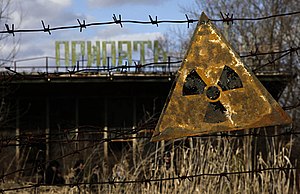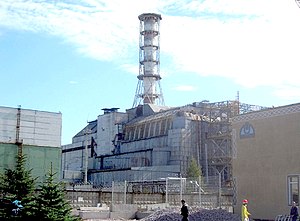The city and region Chernobyl (Ukrainian Chornobyl), made famous by the nuclear disaster on April 26, 1986, is located in the north of the Ukraine.
background
On April 26, 1986, reactor 4 of the Chernobyl nuclear power plant exploded during a routine test. The radioactive iodine released by the explosion was distributed across Europe by air currents. Potassium iodide was distributed in the closer areas around the nuclear power plant, including the Pripyat region, where most of the workers lived. Controlled by the weather conditions, the radioactive cloud rose and fell several times within a radius of 500 km.
A detailed description of the accident and its consequences can be found in the Wikipedia article "Chernobyl disaster" to find.
Pripyat (Pripyat, Prypiat), the city closest to the reactor, was home to nearly 50,000 people before the disaster; nobody lives here today. The city of Chernobyl is located a good 20 km south of the reactor. The high levels of radioactivity made it necessary to relocate 100,000 people from Chernobyl. To date, 700 people have returned to their old homeland.
Prypiat is a frozen eyewitness object from Soviet life in the 1980s. Propaganda slogans are still hanging around, and toys and other personal items are still right where they were. However, the houses are slowly deteriorating, paint is peeling off the walls and looters have taken anything that could be of any value. Trees and grass are reclaiming the land. Today the Chernobyl restricted area is a new tourist destination. In 2002 it opened to tourism and in 2004 there were already 870 visitors.
20 years after the accident, there are still debates about the number of deaths. For a few years, for fear of bad PR, the USSR banned pathologists from citing radiation as the cause of death. Estimates range from a few thousand to nearly a million.
getting there
Pripyat is 110 km from Kiev and 16 km from the border too Belarus away.
To gain access to Pripyat, Chernobyl and the surrounding villages, you have to enter the 30 km exclusion zone. To do this, you have to get access authorization that is valid for one day. The easiest way to get such an authorization is through tour operators, many of whom are in Kiev are resident.
Most of the organized tours are by bus from Kiev. The travel agency Hamalia has a good reputation for ecologically compatible tours in the region. If you want to book a ride, you should do so in advance, as official registration and permits are required.
A day tour as a self-drive in your own private car is also possible. You usually meet at the 30km Dytjatky checkpoint with a guide provided by the travel agent and have to take him on board and follow his instructions. Route and stops can then be agreed individually, including driving through Prypiat, parking only about 250m from reactor 4 and detours to Woodpecker and other sights outside of the main routes are then feasible. Lunch in the Chernobyl canteen is included, and at the end of the tour, both the vehicle and its occupants are checked for possible contamination. This is offered by, for example SoloEast Travel.
On the website pripyat.com organized trips to the exclusion zone are also offered. Former locals lead the tours and share their memories from the time of the accident.
Tourist Attractions
Visitors to the exclusion zone must come in organized groups or - if you are driving your own car - accompanied by a local tourist guide. One-day tours, including travel and meals, cost US $ 200 to 400.


- Reactor 4. It is not possible to get in close proximity, but the sarcophagus can be observed from a parking lot 250 m away or a lookout point 500 m away. Although the radioactivity is much higher here than elsewhere, there is no risk of ingesting a critical amount during the stay. The normal radiation dose at this point is around 0.5 to 0.9 micro-X-rays / hour in winter, and slightly higher in summer.
- Car junkyard. If you are interested, you can see the junkyard where the contaminated motor vehicles that mastered the disaster are lying. There are a number of fire engines, ambulances, trucks and helicopters lying around here. It is not possible to get into the vehicles as some of them still have a lethal dose of radiation, but that is forgivable. There is a viewing platform for taking photos.
- Pripyat. The famous ghost town that once housed 49,000 people. Sights include schools, kindergartens, public buildings and the impressive Palace of Culture, which houses a swimming pool, a cinema and a grammar school and towers above the famous Ferris wheel. The crumbling buildings and rotten wooden floors in the buildings are dangerous. So be careful when entering!
- Villages. There are a large number of abandoned villages in the exclusion zone, and all of them are well worth seeing. You can see barns, small huts and a lot of vegetation here. When entering these areas one should be extremely careful, because the vegetation stores much more radiation than concrete areas.
activities
shop
There is a small supermarket in Chernobyl, but it mainly sells alcohol and some souvenirs. The main catering for the workers is provided by the large canteens. The sightseeing tour may include food, but you should still bring your own snacks and drinks.
If you get access to the Chernobyl administration building, you can buy souvenirs such as books describing the accident.
kitchen
In Pripyat there is a canteen for the maintenance teams who work in the exclusion zone. If you are on a guided tour, you can eat there. All day visitors, on the other hand, will likely dine in the restaurants outside the exclusion zone.
accommodation
A small hotel in Chernobyl is the only place for tourists to stay overnight. The city Slavutych has a few places to stay.
security
Tap water remains unsuitable for drinking and washing. Instead, take bottled water with you, which is widely available in Ukraine.
The lethal radiation dose is around 300 to 500 roentgen per hour. According to measurements, only 15 to a few 100 micro-X-rays are achieved per hour during the tour stages. A micro-x-ray is a millionth of an x-ray. One shouldn't leave the streets; the radiation in overgrown areas is significantly higher.


